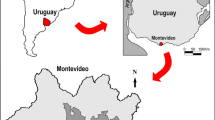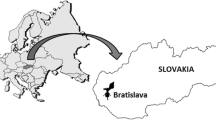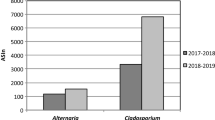Abstract
In this paper, we expose a preliminary study of the airborne fungal spore content in the atmosphere of Salamanca City including a fungal spore calendar. Sampling was carried out between February 2014 and February 2016, and along these 2 years of monitoring Cladosporium was the most abundant type followed by Aspergillus/Penicillium, both present from January to December. The peaks of diversity and abundance were established in two well-defined seasons focused on autumn (especially basidiomycota) and late spring. Others, like Cladosporium and Alternaria, called the dry spore types, had their maximum during summer. According to the intradiurnal pattern, the results were very similar for the spore types, except for Agaricus, Coprinus and Periconia that showed a nocturnal release pattern. The meteorological factors that had a clearly influence on the spore distribution were temperature, in the case of the dry spore types, and relative humidity in the case of wet air spores like Agaricus and Coprinus both basidiomycetes.



Similar content being viewed by others
References
Abu Dieyeh, M. H., Barham, R., Abu Elteen, K., Al Rashidi, R., & Shaheen, I. (2010). Seasonal variation of fungal spore populations in the atmosphere of Zarqa area, Jordan. Aerobiologia, 26, 263–276.
Adams, K. F. (1964). Year to year variation in the fungus spore content of the atmosphere. Acta Allergologica, 19, 11–50.
Adhikari, A., Reponen, T., Grinshpun, S. A., Martuzevicius, D., & LeMasters, G. (2006). Correlation of ambient inhalable bioaerosols with particulate matter and ozone: A two-year study. Environmental Pollution, 140, 16–28.
Aira, M. J., La-Serna, I., & Dopazo, A. (2003). Identification of fungal spores in the atmosphere of Santiago de Compostela (NW Spain) in the winter period. Polen, 12, 65–76.
Aira, M. J., Rodríguez Rajo, F. J., Fernández González, M., Seijo, C., Elvira Rendueles, B., Abreu, I., et al. (2013). Spatial and temporal distribution of Alternaria spores in the Iberian Peninsula atmosphere, and meteorological relationships: 1993–2009. International Journal of Biometeorology, 57, 265–274.
Aira, M. J., Rodríguez Rajo, F. J., Fernández González, M., Seijo, C., Elvira Rendueles, B., Gutiérrez Bustillo, M., et al. (2012). Cladosporium airborne spore incidence in the environmental quality of the Iberian Peninsula. Grana, 51, 293–304.
Almaguer, M., Aira, M. J., Rodríguez Rajo, F. J., Fernández González, M., & Rojas Flores, T. I. (2015). Thirty-four identifiable airborne fungal spores in Havana, Cuba. Annals of Agricultural and Environmental Medicine, 2, 215–220.
Almaguer Chávez, M., Aira, M. J., Tojas, T. I., Fernández González, M., & Rodríguez Rajo, F. J. (2018). New findings of airborne fungal spores in the atmosphere of Havana, Cuba, using aerobiological non-viable methodology. Annals of Agricultural and Environmental Medicine, 25, 349–359.
Almaguer, M., Rojas Flores, T. I., Rodríguez Rajo, F. J., & Aira, M. J. (2014). Airborne basidiospores of Coprinus and Ganoderma in a Caribbean region. Aerobiologia, 30, 197–204.
Almeida, E., Caeiro, E., Todo Bom, A., Ferro, R., Dionisio, A., Duarte, A., et al. (2018). The influence of meteorological parameters on Alternaria and Cladosporium fungal spore concentrations in Beja (Southern Portugal): Preliminary results. Aerobiologia, 34, 219–226.
Bardei, F., Bouziane, H., Trigo, M. M., Ajouray, N., El Haskouri, F., & Kadiri, M. (2017). Atmospheric concentrations and intradiurnal pattern of Alternaria and Cladosporium conidia in Tétouan (NW of Morocco). Aerobiologia, 33, 221–228.
Bednarz, A., & Pawłowska, S. (2016). A fungal spore calendar for the atmosphere of Szczecin, Poland. Acta Agrobotanica, 69, 1–9.
Bush, R. K., & Portnoy, J. M. (2001). The role and abatement of fungal allergens in allergic diseases. Journal of Allergy and Clinical Immunology, 107, 430–440.
Capel Molina, J. (2000). El clima de la Península Ibérica. Ed. Ariel geográfica.
Chen, B., Chao, H. J., Wu, C., Kim, H., Honda, Y., & Guo, Y. L. (2014). High ambient Cladosporium spores were associated with reduced lung function in schoolchildren in a longitudinally study. Science of the Total Environment, 481, 370–376.
Corden, J. M., Millington, W. M., & Mullins, J. (2003). Long-term trends and regional variation in the aeroallergen Alternaria in Cardiff and Derby UK- are differences in climate and cereal production having an effect? Aerobiologia, 19, 191–199.
Damialis, A., & Gioulekas, D. (2006). Airborne allergenic fungal spores and meteorological factors in Greece: Forecasting possibilities. Grana, 45, 122–129.
Damialis, A., Kaimakamis, E., Konoglou, M., Akritidis, I., Traidl Hoffmann, C., & Gioulekas, D. (2017). Estimating the abundance of airborne pollen and fungal spores at variable elevations using an aircraft: How high can they fly? Scientific Reports, 7, 44535.
Das, S., & Gupta Bhattacharya, S. (2008). Enumerating outdoor aeromycota in suburban west Bengal, India, with reference to respiratory allergy and meteorological factors. Annals of Agricultural and Environmental Medicine, 15, 105–112.
Díez Herrero, A., Sabariego Ruiz, S., Gutiérrez Bustillo, M., & Cervigón Morales, P. (2006). Study of airborne fungal spores in Madrid, Spain. Aerobiologia, 22, 135–142.
Domínguez Santana, M. D., & La Serna, I. (1998). Variación anual y diaria del contenido en esporas de Alternaria, Cladosporium, Fusarium y Stemphylium en la atmósfera de La Laguna (Tenerife: Islas Canarias). Acta Botanica Macaronesica, 23, 105–117.
El Haskouri, F., Bouziane, H., Trigo, M. M., Kadiri, M., & Kazzaz, M. (2016). Airborne ascospores in Tétouan (NW Morocco) and meteorological parameters. Aerobiologia, 32, 669–681.
Erkara, I. P., Asan, A., Yilmaz, V., Pehlivan, S., & Okten, S. S. (2008). Airborne Alternaria and Cladosporium species and relationship with meteorological conditions in Eskisehir City, Turkey. Environmental Monitoring and Assessment, 144, 31–41.
Fernández, D., Valencia, R. M., Molnár, T., Vega, A., & Sagüés, E. (1998). Daily and seasonal variations of Alternaria and Cladosporium airborne spores in León (North-West, Spain). Aerobiologia, 14, 215–220.
Frenguelli, G. (1998). The contribution of aerobiology to agriculture. Aerobiologia, 14, 95–100.
Galán, C., Ariatti, A., Bonini, M., Clot, B., Crouzy, B., Dahl, A., et al. (2017). Recommended terminology for aerobiological studies. Aerobiologia, 33, 293–295.
Galán, C., Cariñanos, P., Alcázar, P., & Domínguez, E. (2007). Spanish aerobiology network (REA: Management and quality manual. Servicio de Publicaciones de la Universidad de Córdoba 2007. http://www.uco.es/rea/infor_rea/manual_eng.pdf.
Galán, C., Smith, M., Thibaudon, M., Frenguelli, G., Oteros, J., Gehrig, R., et al. (2014). Pollen monitoring: Minimum requirements and reproducibility of analysis. Aerobiologia, 30, 385–395.
Galán, C., Tormo, R., Cuevas, J., Infante, F., & Domínguez, E. (1991). Theoretical daily variations patterns of airborne pollen in south-west of Spain. Grana, 30, 201–209.
Grant Smith, E. (2000). Sampling and identifying allergenic pollens and molds. San Antonio, TX: Blewstone Press.
Grinn Gofroń, A. (2011). Airborne Aspergillus and Penicillium in the atmosphere of Szczecin (Poland) (2004-2009). Aerobiologia, 27, 67–76.
Grinn Gofroń, A., & Bosiacka, B. (2015). Effects of meteorological factor on the composition of selected fungal spores in the air. Aerobiologia, 31, 63–72.
Grinn Gofroń, A., Bosiacka, B., Bednarz, A., & Wolski, T. (2018). A comparative study of hourly and daily relationships between selected meteorological parameters and airborne fungal spore composition. Aerobiologia, 34, 45–54.
Grinn Gofroń, A., Sadyś, M., Kaczmarek, J., Bednarz, A., Pawlowska, S., & Jedryczka, M. (2016a). Back-trajectory modelling and DNA-based species-specific detection methods allow tracking of fungal spore transport in air masses. Science of the Total Environment, 571, 658–669.
Grinn Gofroń, A., Strzelczak, A., Stępalska, D., & Myszkowska, D. (2016b). A 10-year study of Alternaria and Cladosporium in two Polish cities (Szczecin and Cracow) and relationship with the meteorological parameters. Aerobiologia, 32, 83–94.
Haas, D., Habib, J., Luxner, J., Galler, H., Zarfel, G., Schlacher, R., et al. (2014). Comparison background levels of culturable fungal spore concentrations in indoor and outdoor air in southeastern Austria. Atmospheric Environment, 98, 640–647.
Hasnain, S. M., Akhter, T., & Waqar, M. A. (2012). Airborne and allergenic fungal spores of the Karachi environment and their correlation with meteorological factors. Journal of Environmental Monitoring, 14, 1006–1013.
Hasnain, S. M., Fatima, K., Al Frayh, A., & Al Sedairy, S. T. (2005). Prevalence of airborne basidiospores in three coastal cities of Saudi Arabia. Aerobiologia, 21, 139–145.
Heinzerling, L. M., Burbach, G. J., Edenharter, G., Bachert, C., Bindslev Jensen, C., Bonini, S., et al. (2009). GA2LEN skin test study I: GA2LEN harmonization of skin prick testing: novel sensitization patterns for inhalant allergens in Europe. Allergy, 64, 1498–1506.
Hernández Trejo, F., Muñoz Rodríguez, A., Tormo Molina, R., & Silva Palacios, I. (2012). Airborne ascospores in Mérida (SW Spain) and the effect of rain and other meteorological parameters on their concentration. Aerobiologia, 28, 13–26.
Hirst, J. M. (1952). An automatic volumetric spore trap. Annals of Applied Biology, 39, 257–265.
Ho, H., Rao, C. Y., Hsu, H., Chiu, Y., Liu, C., & Chao, H. J. (2005). Characteristics and determinant of ambient fungal spores in Hualien, Taiwan. Atmospheric Environment, 39, 5839–5850.
Huang, Y. J., Fitt, B. D. L., Jedryczka, M., Dakowska, S., West, J. S., Gladders, P., et al. (2005). Patterns of ascospore release in relation to phoma stem canker epidemiology in England (Leptosphaeria maculans) and Poland (Leptosphaeria biglobosa). European Journal of Plant Pathology, 111, 263–277.
Ianovici, N. (2016). Atmospheric concentrations of selected allergenic fungal spores in relation to some meteorological factors, in Timişoara (Romania). Aerobiologia, 32, 139–156.
Irga, P. J., & Torpy, F. R. (2016). A survey of the aeromycota of Sydney and its correspondence with environmental conditions: Grass as a component of urban forestry could be a major determinant. Aerobiologia, 32, 171–185.
Jedryczka, M., Kaczmarek, J., Dawidziuk, A., & Brachaczek, A. (2008). System for forecasting disease epidemics—Aerobiological methods in Polish agriculture. Aspects of Applied Biology, 89, 1–6.
Kaczmarek, J., Kedziora, A., Brachaczek, A., Latunde Dada, A. O., Dakowska, S., Karg, G., et al. (2016). Effect of climate change on sporulation of the teleomorphs of Leptosphaeria species causing stem canker of brassicas. Aerobiologia, 32, 39–51.
Kasprzyk, I., & Worek, M. (2006). Airborne fungal spores in urban and rural environments in Poland. Aerobiologia, 22, 169–176.
Katotomichelakis, M., Nikolaidis, C., Makris, M., Proimos, E., Aggelides, X., Constantinidis, T. C., et al. (2016). Alternaria and Cladosporium calendar of western Thrace: Relationship with allergic rhinitis symptoms. Laryngoscope, 126, E51–E56.
Khan, M., Perveen, A., & Qaiser, M. (2016). Seasonal and diurnal variation of atmospheric fungal spore concentrations in Hyderabad, Tandojam-Sindh and the effects of climatic conditions. Pakistan Journal of Botany, 48, 1657–1663.
Levetin, E., & Horner, W. E. (2002). Fungal aerobiology: Exposure and measurements. Chemical Immunology, 81, 10–27.
Licorish, K., Novery, H. S., Kozak, P., Fairshter, R. D., & Wilson, A. F. (1985). Role of Alternaria and Penicillium spores in the pathogenesis of asthma. Journal of Allergy and Clinical. Immunology, 76, 819–825.
Magyar, D., Barasits, T., Fischl, G., & Fernando, W. G. D. (2006). First report of the natural occurrence of the teleomorph of Leptosphaeria maculans on oilseed rape and airborne dispersal of ascospores in Hungary. Journal of Phytopathology, 154, 428–431.
Magyar, D., Kállai, Z., Sipiezki, M., Dobolyi, C., Sebök, F., Beregszászi, T., et al. (2018). Survey of viable airborne fungi in wine cellars of Tokaj, Hungary. Aerobiologia, 34, 171–185.
Mallo, A. C., Nitiu, D. S., & Gardella Sambeth, M. C. (2011). Airborne fungal spore content in the atmosphere of the city of La Plata, Argentina. Aerobiologia, 27, 77–84.
Martínez Bracero, M., Alcázar, P., Velasco Jiménez, M. J., & Galán, C. (2018). Fungal spores affecting vineyards in Montilla-Moriles southern Spain. European Journal of Plant Pathology, 153, 1–13.
Maya Manzano, J. M., Muñoz Triviño, M., Fernández Rodríguez, S., Silva Palacios, I., Gonzálo Garijo, A., & Tormo Molina, R. (2016). Airborne Alternaria conidia in Mediterranean rural environments in SW of Iberian Peninsula and weather parameters that influence their seasonality in relation to climate change. Aerobiologia, 32, 95–108.
Mitakakis, T. Z., & Guest, D. I. (2001). A fungal spore calendar for the atmosphere of Melbourne, Australia, for the year 1993. Aerobiologia, 17, 171–176.
Morales, J., González Minero, F. J., Carrasco, M., Ogalla, V. M., & Candau, P. (2006). Airborne basidiospores in the atmosphere of Seville (South Spain). Aerobiologia, 22, 127–134.
Nilsson, S., & Persson, S. (1981). Tree pollen spectra in the Stockholm region (Sweden) 1973–1980. Grana, 20, 179–182.
O’Connor, D. J., Sadyś, M., Skjøth, C. A., Healy, D. A., Kennedy, R., & Sodeau, J. R. (2014). Atmospheric concentrations of Alternaria, Cladosporium, Ganoderma and Didymella spores monitored in Cork (Ireland) and Worcester (England) during the summer of 2010. Aerobiologia, 30, 397–411.
O’Gorman, C. M., & Fuller, H. T. (2008). Prevalence of culturable airborne spores of selected allergenic and pathogenic fungi in outdoor air. Atmospheric Environment, 42, 4355–4368.
Oliveira, M., Ribeiro, H., Delgado, J. L., & Abreu, I. (2009a). The effects of meteorological factors on airborne fungal spore concentration in two areas differing in urbanisation level. International Journal of Biometeorology, 53, 61–73.
Oliveira, M., Ribeiro, H., Delgado, J. L., & Abreu, I. (2009b). Seasonal and intradiurnal variation of allergenic fungal spores in urban and rural areas of the North of Portugal. Aerobiologia, 25, 85–98.
Pérez Gorjón, S., Rodríguez de la Cruz, D., González Suarez, R., & Sánchez, J. (2003). Variación anual de esporas en la atmósfera de Salamanca durante los años 1995 y 2000. Polen, 13, 289–297.
Pyrri, I., & Kapsanaki Gotsi, E. (2007). A comparative study on the airborne fungi in Athens, Greece, by viable and non-viable samplings methods. Aerobiologia, 23, 3–15.
Pyrri, I., & Kapsanaki Gotsi, E. (2015). Evaluation of the fungal aerosol in Athens, Greece, based on spore analysis. Aerobiologia, 31, 179–190.
Pyrri, I., & Kapsanaki Gotsi, E. (2017). Functional relations of airborne fungi to meteorological and pollution factor in a Mediterranean urban environment. Fungal Ecology, 30, 48–54.
Rivas Martínez, S. (2007). Mapa de series, geoseries y geopermaseries de vegetación de España [Memoria del Mapa de Vegetación Potencial de España. Parte I]. Itinera Geobotánica, 17(1), 1–436.
Rodríguez, D., Dávila, I., Sánchez, E., Barber, D., Lorente, F., & Sánchez, J. (2011). Relationship between airborne pollen counts and the results obtained using 2 diagnostic methods: Allergen-specific immunoglobulin E concentrations and skin prick tests. Journal of Investigational Allergology and Clinical Immunology, 21, 222–228.
Rosas, I., Calderón, C., Ulloa, M., & Lacey, J. (1993). Abundance of Airborne Penicillium CFU in relation to urbanization in Mexico City. Applied and Environmental Microbiology, 59, 2648–2652.
Sabariego, S., Bouso, V., & Pérez Badia, R. (2012). Comparative study of airborne Alternaria conidia levels in two cities in Castilla–La Mancha (central Spain), and correlations with weather-related variables. Annals of Agricultural and Environmental Medicine, 2, 227–232.
Sabariego, S., Díez, A., & Gutiérrez, M. (2007). Monitoring of airborne fungi in Madrid (Spain). Acta Botanica Croatica, 66, 117–126.
Sabariego, S., Guardia, C. D., & Alba, F. (2000). The effect of meteorological factor on the daily variation of airborne fungal spores in Granada (Southern Spain). International Journal of Biometeorology, 44, 1–5.
Sadyś, M. (2017). Effect of wind speed and direction on monthly fluctuations of Cladosporium conidia concentration in the air. Aerobiologia, 33, 445–456.
Sadyś, M., Adams Groom, B., Herbert, R. J., & Kennedy, R. (2016). Comparisons of fungal spore distributions using air sampling at Worcester, England (2006–2010). Aerobiologia, 32, 619–634.
Sadyś, M., Kaczmarek, J., Grinn Gofroń, A., Rodinkova, V., Prikhodko, A., Bilous, E., et al. (2018). Dew point temperature affects ascospore release of allergenic genus Leptosphaeria. International Journal of Biometeorology, 62, 979–990.
Sáenz, C., & Gutiérrez-Bustillo, M. (2003). Esporas atmosféricas en la Comunidad de Madrid. Documento Técnico de Salud Pública nº 83, Madrid.
Sánchez Reyes, E., Rodríguez de la Cruz, D., & Sánchez, J. (2007). Contenido atmosférico de esporas de Ganoderma P. Karst. en la atmosfera de Valladolid. Polen, 17, 39–49.
Sánchez Reyes, E., Rodríguez de la Cruz, D., & Sánchez, J. (2012). Influencia de la temperatura sobre las concentraciones de esporas de Periconia sl en Valladolid (2005-2007). Polen, 22, 9–13.
Sánchez Reyes, E., Rodríguez de la Cruz, D., & Sánchez Sánchez, J. (2016). First fungal spore calendar of the middle-west of the Iberian Peninsula. Aerobiologia, 32, 529–539.
Sánchez Reyes, E., Rodríguez de la Cruz, D., Sanchís Merino, M. E., & Sánchez, J. (2009a). First results of Platanus pollen airborne content in the middle-west of the Iberian Peninsula. Aerobiologia, 25, 209–215.
Sánchez Reyes, E., Rodríguez de la Cruz, D., Sanchís Merino, M. E., & Sánchez, J. (2009b). Meteorological and agricultural effects on airborne Alternaria and Cladosporium spores and clinical aspects in Valladolid (Spain). Annals of Agricultural and Environmental Medicine, 16, 53–61.
Sindt, C., Besancenot, J. P., & Thibaudon, M. (2016). Airborne Cladosporium fungal spores and climate change in France. Aerobiologia, 32, 53–68.
Skjøth, C. A., Damialis, A., Belmonte, J., De Linares, C., Fernández Rodríguez, S., Grinn Gofroń, A., et al. (2016). Alternaria spores in the air across Europe: Abundance, seasonality and relationships with climate, meteorology and local environment. Aerobiologia, 32, 3–22.
Sousa, L., Câmara Camacho, I., Grinn Gofroń, A., & Camacho, R. (2016). Monitoring of anamorphic fungal spores in Madeira region (Portugal), 2003–2008. Aerobiologia, 32, 303–315.
Spieksma, F. (1991). Regional European Pollen Calendars. In G. D’Amato, F. Th, M. Spieksma, & S. Bonini (Eds.), Allergenic pollen and pollinosis in Europe (pp. 49–65). Oxford: Blackwell Scientific Publications.
Tham, R., Vicendese, D., Dharmage, S. C., Hindman, R. J., Newbigin, E., Lewis, E., et al. (2017). Associations between outdoor fungal spores and childhood and adolescent asthma hospitalizations. Journal of Allergy and Clinical Immunoly, 139, 1140–1147.
Vélez Pereira, A. M., De Linares, C., Delgado, R., & Belmonte, J. (2016). Temporal trends of the airborne fungal spores in Catalonia (NE Spain), 1995–2013. Aerobiologia, 32, 23–37.
Author information
Authors and Affiliations
Corresponding author
Rights and permissions
About this article
Cite this article
Antón, S.F., de la Cruz, D.R., Sánchez, J.S. et al. Analysis of the airborne fungal spores present in the atmosphere of Salamanca (MW Spain): a preliminary survey. Aerobiologia 35, 447–462 (2019). https://doi.org/10.1007/s10453-019-09569-z
Received:
Accepted:
Published:
Issue Date:
DOI: https://doi.org/10.1007/s10453-019-09569-z




